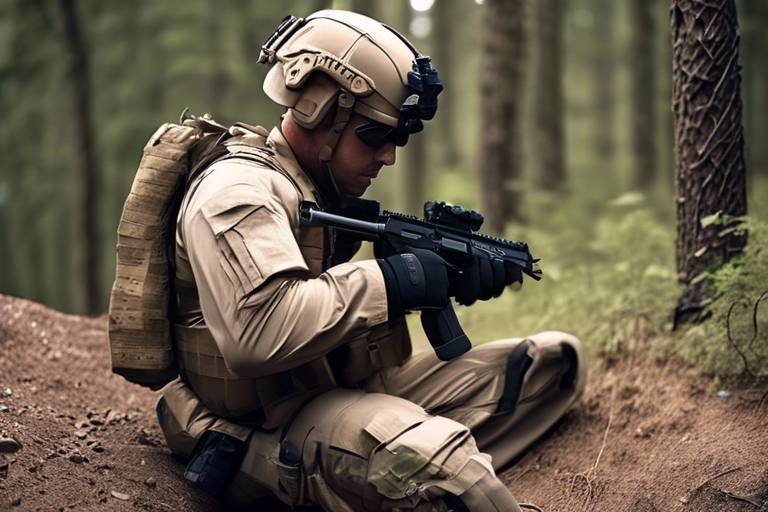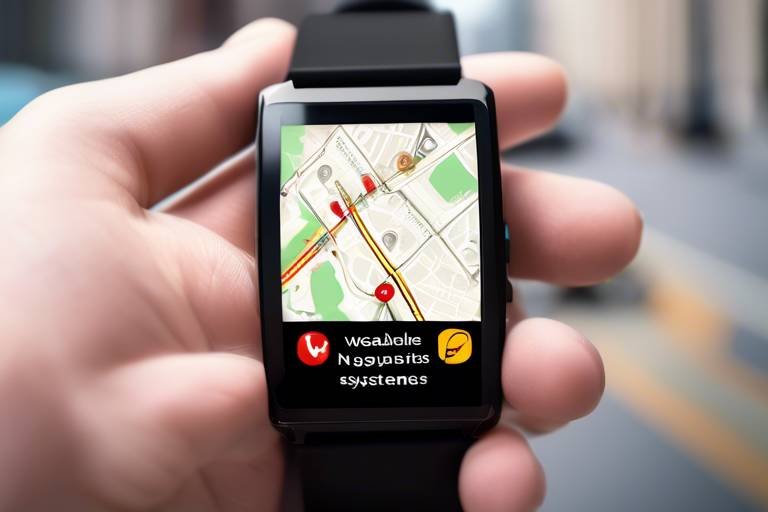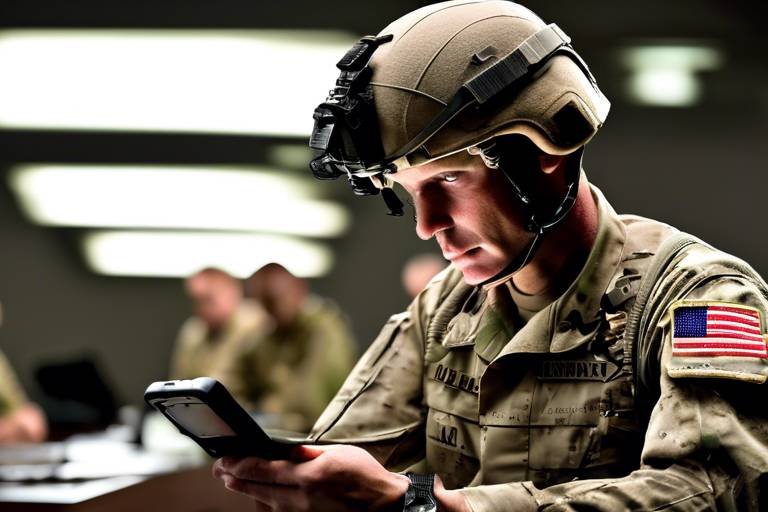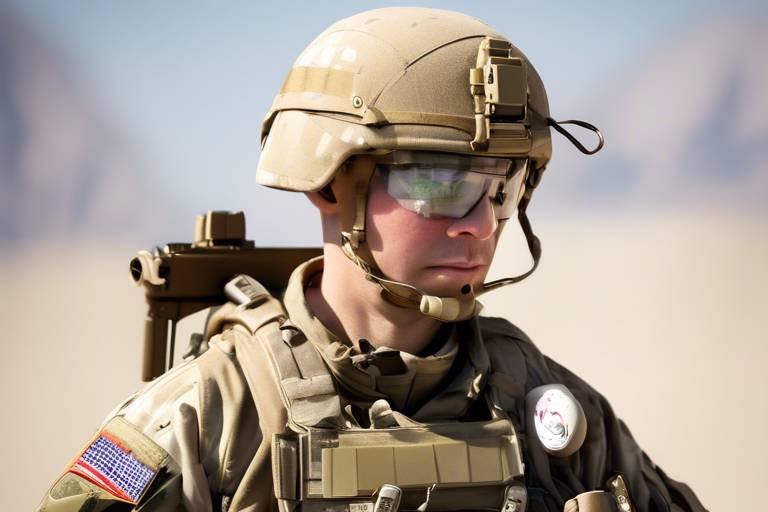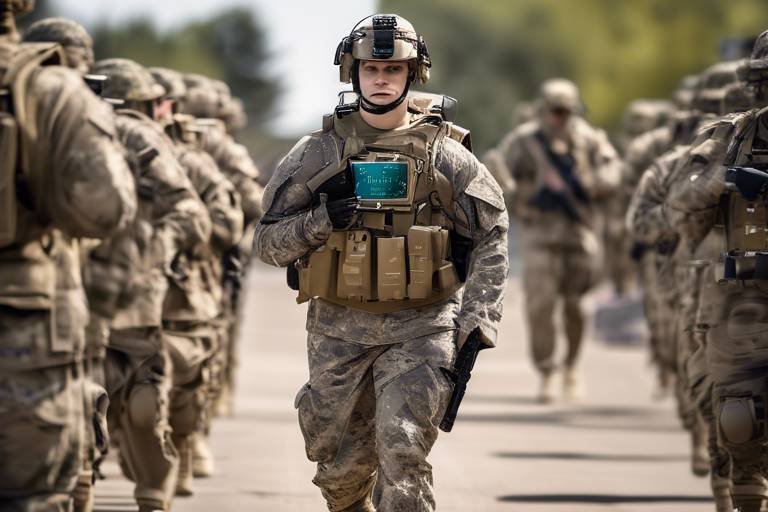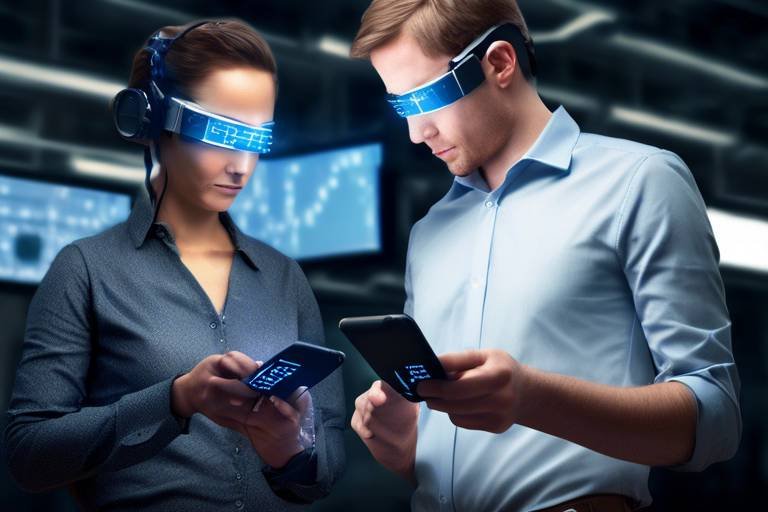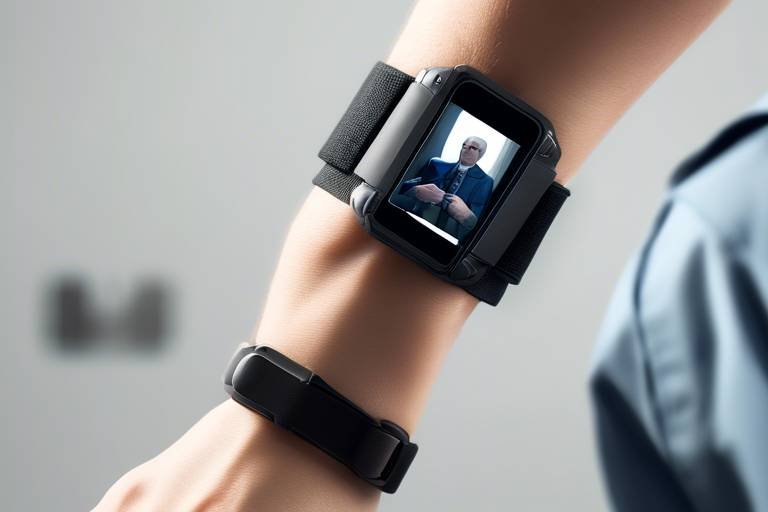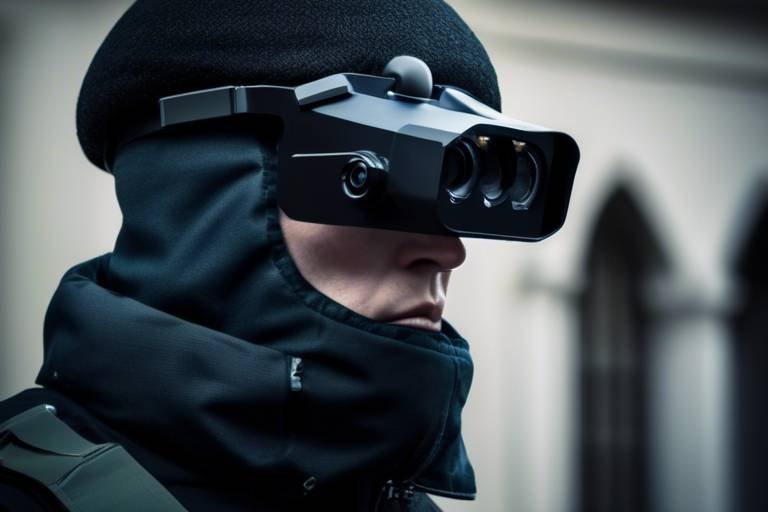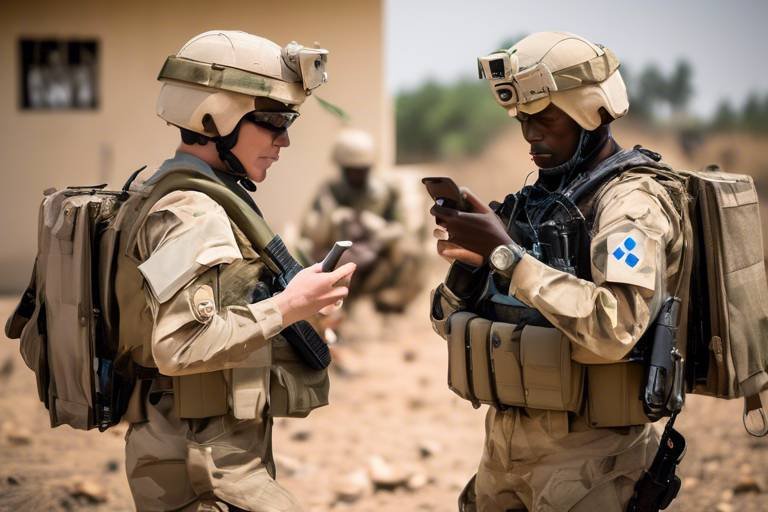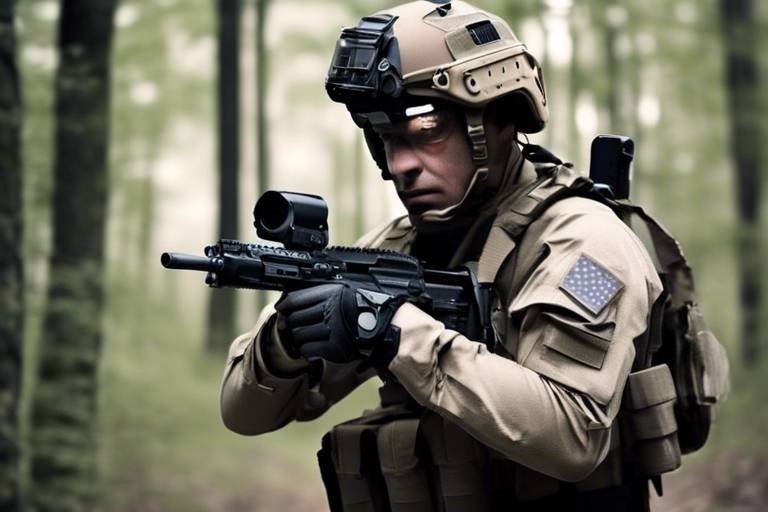The Benefits of Wearable Technology for Tactical Communication
In today's fast-paced world, the need for efficient and reliable communication has never been more critical, especially in high-stakes environments like the military, emergency services, and outdoor adventures. This is where wearable technology comes into play, revolutionizing the way teams operate and communicate. Imagine a world where every member of a tactical unit has instant access to vital information, can alert their team at a moment's notice, and maintain a heightened sense of awareness—all thanks to the power of wearable devices. This article delves into how these innovations are transforming tactical communication, enhancing efficiency, safety, and situational awareness.
Wearable technology is a game-changer when it comes to communication efficiency. Traditional methods often involve cumbersome equipment and delayed responses, which can be detrimental in critical situations. With wearables, instant messaging and voice commands become the norm. Picture this: a team member in the field can send a quick voice command to relay information to their squad leader—no fumbling with radios or phones, just swift and seamless communication. This capability significantly reduces response times and enhances overall operational effectiveness, allowing teams to react faster and more decisively when it matters most.
Maintaining situational awareness is crucial in any tactical environment. Wearable devices are equipped with technology that provides real-time data and notifications, ensuring users are always aware of their surroundings. For example, imagine a firefighter entering a burning building; with a wearable device, they can receive updates about the fire's intensity, their team’s location, and even the structural integrity of the building. This real-time information is vital for making informed decisions, ultimately improving safety and effectiveness in high-stakes scenarios.
One of the standout features of wearable technology is its ability to integrate seamlessly with other devices. These wearables can connect with smartphones, tablets, and other communication tools, creating a comprehensive network that enhances collaboration and information sharing among team members. For instance, a tactical unit can share live updates, maps, and critical data instantly, ensuring everyone is on the same page. Such integration not only boosts efficiency but also fosters a sense of unity and teamwork, critical components in any successful mission.
Advanced wearables come equipped with robust data-sharing capabilities. Imagine a scenario where all team members have access to the same up-to-date information during a mission. This capability is vital, especially in emergency responses where every second counts. By ensuring that everyone is informed, wearables help eliminate confusion and streamline operations, ultimately enhancing the effectiveness of the mission.
Many wearable devices also include remote monitoring functionalities, allowing leaders to track the status and location of their team members in real-time. This feature is particularly crucial for ensuring safety and providing prompt assistance when needed. For example, in a search and rescue operation, team leaders can monitor the health and location of each member, ensuring that help is dispatched immediately if someone is in distress. This added layer of safety can be lifesaving, making wearable technology an indispensable tool in tactical situations.
The intuitive design of wearable devices makes them accessible to users of all skill levels. Whether you're a seasoned professional or a newcomer to tactical operations, these devices are designed with user-friendliness in mind. This means that tactical teams can adopt the technology without extensive training, allowing them to focus on what truly matters: their mission. The ease of use ensures that everyone can benefit from the advancements in communication technology, leading to a more efficient and cohesive team.
When it comes to tactical operations, safety is paramount. Wearable technology enhances safety by providing features such as location tracking and emergency alerts. These functionalities can be lifesaving in dangerous situations. For instance, if a team member finds themselves in a precarious position, they can quickly activate an emergency alert, notifying their team and ensuring that help is on the way without delay. This proactive approach to safety transforms the way teams operate, allowing them to focus on their objectives with peace of mind.
Many wearables are equipped with dedicated emergency buttons that allow users to send distress signals quickly. This feature is crucial in scenarios where time is of the essence. Think about it: in a high-pressure situation, the ability to signal for help with a single press of a button can mean the difference between life and death. Such emergency response features are designed to ensure that help can be dispatched without delay, reinforcing the safety net that wearable technology provides.
In addition to communication features, wearable devices often include health monitoring capabilities. These functionalities allow users to track vital signs and physical conditions, which is essential for maintaining operational readiness and well-being in the field. For example, a soldier can monitor their heart rate and fatigue levels, ensuring they are fit for duty. This focus on health not only enhances individual performance but also contributes to the overall success of the team.
Investing in wearable technology can lead to long-term cost savings for organizations. By reducing the need for traditional communication equipment and enabling scalable solutions, wearables provide a cost-effective alternative that grows with organizational needs. As teams expand or adapt to new challenges, wearable technology can easily evolve to meet those demands, making it a smart investment for the future.
- What types of wearable technology are available for tactical communication?
There are various types of wearable devices, including smartwatches, fitness trackers, and specialized communication headsets designed for tactical environments. - How do wearables enhance safety in emergency situations?
Wearables provide features such as location tracking, emergency alerts, and health monitoring, ensuring that help can be dispatched quickly and that team members' well-being is monitored. - Are wearable devices easy to use for all team members?
Yes, the intuitive design of most wearable devices makes them accessible to users of all skill levels, allowing for quick adoption without extensive training. - Can wearables integrate with existing communication systems?
Absolutely! Many wearable devices can seamlessly connect with smartphones, tablets, and other communication tools, enhancing collaboration and information sharing.
Improved Communication Efficiency
This article explores how wearable technology enhances tactical communication, improving efficiency, safety, and situational awareness in various fields, including military, emergency services, and outdoor adventures.
When it comes to tactical operations, every second counts. That's where wearable technology steps in, revolutionizing the way teams communicate in the field. Imagine a scenario where a soldier, firefighter, or rescue worker can send a message or issue a command with just a voice command or a tap on their wrist. This capability significantly reduces response times in critical situations. In environments where split-second decisions can mean the difference between success and failure, the efficiency of communication can be a game-changer.
Wearable devices are designed to streamline communication processes, allowing for instant messaging and voice commands. This means that instead of fumbling with bulky radios or smartphones, team members can focus on their tasks at hand. With features like push-to-talk functionality and hands-free operation, wearables ensure that communication flows seamlessly, even when hands are busy or when conditions are less than ideal.
To illustrate the impact of improved communication efficiency, consider the following:
| Traditional Communication | Wearable Technology |
|---|---|
| Delayed response times | Instant messaging and voice commands |
| Complex equipment | Simple, user-friendly interfaces |
| Limited connectivity | Seamless integration with other devices |
Furthermore, the integration of wearables with other devices, such as smartphones and tablets, creates a comprehensive communication network. This interconnectedness enhances collaboration and information sharing among team members, ensuring that everyone is on the same page. Imagine a tactical team where data flows freely, and every member has access to real-time updates and critical information. This level of connectivity not only boosts operational effectiveness but also fosters a sense of unity among team members.
In addition to enhancing communication, wearables often come equipped with data-sharing capabilities. This means that during missions or emergency responses, all team members can access the same information simultaneously. The ability to share maps, operational plans, and real-time updates can be vital in ensuring that everyone knows their role and can act swiftly and effectively.
In conclusion, the impact of wearable technology on communication efficiency cannot be overstated. By providing instant communication, seamless integration with other devices, and robust data-sharing capabilities, wearables are setting a new standard for tactical operations. They not only improve response times but also enhance overall operational effectiveness, making them an invaluable tool in high-stakes environments.
Wearables provide real-time data and notifications, enabling users to maintain awareness of their surroundings, which is crucial for making informed decisions in high-stakes environments.
Wearable tech can seamlessly connect with smartphones, tablets, and other devices, facilitating a comprehensive communication network that enhances collaboration and information sharing among team members.
Advanced wearables allow for quick data sharing, ensuring that all team members have access to the same information, which can be vital during missions or emergency responses.
Many wearables include remote monitoring functionalities, enabling leaders to track the status and location of team members, ensuring safety and prompt assistance when needed.
The intuitive design of wearable devices makes them accessible to users of all skill levels, ensuring that tactical teams can adopt the technology without extensive training.
Wearable technology enhances safety by providing features such as location tracking and emergency alerts, which can be lifesaving in dangerous situations or environments.
Many wearables are equipped with emergency buttons, allowing users to send distress signals quickly, ensuring that help can be dispatched without delay.
Wearable devices often include health monitoring capabilities, allowing users to track vital signs and physical conditions, which is essential for maintaining operational readiness and well-being in the field.
Investing in wearable technology can lead to long-term cost savings by reducing the need for traditional communication equipment and enabling scalable solutions that grow with organizational needs.
Q: How do wearables improve communication in tactical situations?
A: Wearables enhance communication by providing instant messaging and voice command capabilities, allowing for quick and efficient communication without the need for bulky equipment.
Q: Are wearable devices user-friendly?
A: Yes! Most wearable devices are designed with intuitive interfaces, making them accessible to users of all skill levels.
Q: Can wearables integrate with other technology?
A: Absolutely! Wearable technology can seamlessly connect with smartphones, tablets, and other devices, creating a comprehensive communication network.
Enhanced Situational Awareness
In today's fast-paced world, situational awareness is more crucial than ever, especially in high-stakes environments like military operations, emergency responses, and outdoor adventures. Wearable technology has emerged as a game-changer, providing users with real-time data and notifications that keep them informed about their surroundings. Imagine being in a critical mission where every second counts; having access to immediate information can mean the difference between success and failure. This technology enhances not only individual awareness but also collective understanding among team members, creating a more cohesive unit.
One of the standout features of wearables is their ability to deliver real-time alerts. Whether it’s a sudden change in weather conditions during a rescue operation or an unexpected movement of an adversary in a tactical scenario, wearables can notify users instantly. This immediate feedback loop allows for rapid decision-making, enabling teams to react promptly to evolving situations. For example, a soldier on the ground can receive updates about enemy positions or changes in mission parameters without needing to rely on cumbersome communication devices.
Moreover, wearables can seamlessly integrate with other devices, forming a comprehensive communication network. This integration allows for a flow of information that is not only quick but also reliable. Imagine a scenario where a team leader is coordinating a rescue operation: they can monitor the status of each team member, view their locations on a map, and receive updates on the environmental conditions—all from their wrist. This level of connectivity enhances situational awareness significantly and ensures that everyone is on the same page.
The ability of wearable technology to connect with smartphones, tablets, and other devices is a significant advantage. This connectivity allows for a centralized hub of information where users can access critical data without having to switch devices. For instance, a firefighter can receive alerts about building stability or the presence of hazardous materials directly on their wearable device while focusing on the task at hand. This integration not only increases efficiency but also reduces the cognitive load on users, allowing them to concentrate on their immediate environment.
Advanced wearables come equipped with sophisticated data-sharing capabilities. This feature ensures that all team members have access to the same information, which is vital during missions or emergency responses. When every member of a team is informed, it fosters a sense of unity and purpose. For example, during a search and rescue operation, if one team member discovers a potential victim, they can share their location and status with the entire team instantly, enabling a coordinated and efficient response.
Another crucial aspect of wearables is their remote monitoring functionalities. These features allow leaders to track the status and location of team members in real-time, ensuring safety and prompt assistance when needed. For instance, in military operations, commanders can monitor troop movements and health status to make informed tactical decisions. This remote oversight not only enhances safety but also boosts morale, knowing that support is always just a signal away.
In conclusion, the integration of wearable technology in tactical environments significantly enhances situational awareness. By providing real-time data, facilitating seamless communication, and allowing for remote monitoring, these devices empower users to make informed decisions swiftly. As we continue to embrace technological advancements, the importance of situational awareness will only grow, making wearables an invaluable asset in various fields.
- What types of wearable technology are commonly used in tactical environments?
Wearable technology includes smartwatches, fitness trackers, augmented reality glasses, and communication headsets, all designed to enhance operational efficiency. - How do wearables improve safety in emergency situations?
Wearables provide features like location tracking, emergency alerts, and health monitoring, which can be lifesaving in critical situations. - Can wearables be integrated with existing communication systems?
Yes, most wearable devices are designed to integrate seamlessly with smartphones and other communication tools, enhancing overall connectivity. - Are wearable devices user-friendly for all skill levels?
Absolutely! The intuitive design of these devices ensures that they are accessible to users of all skill levels, requiring minimal training.
Integration with Other Devices
This article explores how wearable technology enhances tactical communication, improving efficiency, safety, and situational awareness in various fields, including military, emergency services, and outdoor adventures.
Wearable technology streamlines communication, allowing for instant messaging and voice commands, which significantly reduces response times in critical situations, enhancing overall operational effectiveness.
Wearables provide real-time data and notifications, enabling users to maintain awareness of their surroundings, which is crucial for making informed decisions in high-stakes environments.
In today's fast-paced world, the ability to integrate wearable technology with other devices is a game-changer for tactical communication. Imagine being in a high-pressure situation, where every second counts. With wearables that can seamlessly connect to smartphones, tablets, and even specialized communication systems, the flow of information becomes smoother than ever. This integration creates a comprehensive communication network that enhances collaboration and information sharing among team members.
For instance, a tactical team member wearing a smart headset can receive real-time updates directly from their command center while simultaneously sharing their location and status. This not only keeps everyone informed but also allows for faster decision-making. The integration of wearables with other devices can be broken down into several key features:
- Real-Time Notifications: Wearables can receive alerts from various sources, ensuring that users are always in the loop.
- Data Synchronization: Information collected from wearables can be synchronized with other devices, allowing for comprehensive data analysis and situational awareness.
- Voice Commands: Many wearables support voice commands, enabling hands-free operation, which is essential in tactical scenarios.
Moreover, the ability to integrate with GPS and mapping applications means that team members can not only communicate but also navigate effectively in unfamiliar terrains. This synergy between devices ensures that tactical teams are not just connected but are operating as a cohesive unit, ready to respond to any challenge that comes their way.
Advanced wearables allow for quick data sharing, ensuring that all team members have access to the same information, which can be vital during missions or emergency responses.
Many wearables include remote monitoring functionalities, enabling leaders to track the status and location of team members, ensuring safety and prompt assistance when needed.
The intuitive design of wearable devices makes them accessible to users of all skill levels, ensuring that tactical teams can adopt the technology without extensive training.
Wearable technology enhances safety by providing features such as location tracking and emergency alerts, which can be lifesaving in dangerous situations or environments.
Many wearables are equipped with emergency buttons, allowing users to send distress signals quickly, ensuring that help can be dispatched without delay.
Wearable devices often include health monitoring capabilities, allowing users to track vital signs and physical conditions, which is essential for maintaining operational readiness and well-being in the field.
Investing in wearable technology can lead to long-term cost savings by reducing the need for traditional communication equipment and enabling scalable solutions that grow with organizational needs.
- What are wearable technologies? Wearable technologies are electronic devices worn on the body, often integrated with software to provide various functionalities, including communication, health monitoring, and navigation.
- How do wearables improve tactical communication? Wearables enhance tactical communication by providing real-time data, facilitating instant messaging, and integrating with other devices for seamless information sharing.
- Are wearable devices user-friendly? Yes, most wearable devices are designed to be intuitive and user-friendly, making them accessible to users of all skill levels without the need for extensive training.
- Can wearables help in emergency situations? Absolutely! Many wearables come equipped with emergency response features, allowing users to send distress signals and receive immediate assistance.
Data Sharing Capabilities
In today's fast-paced environments, the ability to share data swiftly and efficiently can be the difference between success and failure. Wearable technology excels in this area, offering advanced data sharing capabilities that empower teams to operate seamlessly. Imagine you're in the midst of a high-stakes mission, and every second counts. With wearables, crucial information can be disseminated instantly, ensuring everyone is on the same page. This rapid communication not only enhances team coordination but also fosters a sense of unity and purpose.
One of the standout features of modern wearables is their ability to connect with various devices, creating a robust communication network. For instance, a tactical team can utilize a combination of smartwatches and mobile devices to share real-time updates, location data, and mission-critical information. This interconnectivity allows for a dynamic flow of information, making it easier for team members to adapt to changing situations. The result? A more agile and responsive team ready to tackle any challenge that comes their way.
Moreover, the data sharing capabilities of wearables often include the use of cloud-based platforms. This means that information can be stored, accessed, and analyzed from anywhere, at any time. Such functionality is particularly beneficial in emergency services, where having access to historical data can inform decision-making processes. For example, if a fire department is responding to an emergency, they can pull up previous incident reports and real-time data to strategize their approach effectively.
Additionally, these wearables can facilitate group communication through features like group messaging and alerts. Imagine a scenario where a team is operating in a remote area. With the push of a button, a message can be sent to all team members, notifying them of a change in plan or an emerging threat. This level of connectivity ensures that no one is left in the dark, which is vital for maintaining safety and operational efficiency.
Ultimately, the data sharing capabilities of wearable technology represent a significant leap forward in tactical communication. By ensuring that all team members have access to the same information in real-time, wearables enhance collaboration, improve situational awareness, and ultimately lead to better outcomes in the field. As these technologies continue to evolve, we can expect even more innovative solutions that will redefine how teams communicate and operate under pressure.
- What types of data can be shared using wearable technology?
Wearable technology can share various types of data, including location information, health metrics, and mission-critical updates. - How does wearable technology improve team communication?
By allowing for instant messaging and real-time data sharing, wearables enhance communication efficiency, ensuring everyone is informed and coordinated. - Are wearables user-friendly for all team members?
Yes, most wearable devices are designed with intuitive interfaces, making them accessible to users of all skill levels. - Can wearables integrate with existing communication systems?
Absolutely! Many wearables can connect with smartphones, tablets, and other devices to create a comprehensive communication network.
Remote Monitoring Features
In today's fast-paced and often unpredictable environments, the importance of remote monitoring features in wearable technology cannot be overstated. These functionalities allow leaders and team members to keep a close eye on the status and location of individuals, ensuring a level of safety and efficiency that traditional communication methods simply cannot match. Imagine being in a high-stress situation where every second counts; the ability to instantly check on a teammate's location or health status can be the difference between success and failure.
Wearable devices equipped with remote monitoring capabilities use GPS and other tracking technologies to provide real-time updates. This feature not only enhances situational awareness but also enables quick decision-making. For instance, if a team member is in distress or straying too far from the designated area, alerts can be sent out immediately. This allows for rapid response, ensuring that help is dispatched without unnecessary delays.
Moreover, these wearables often come with integrated health monitoring functionalities. They can track vital signs such as heart rate, body temperature, and even stress levels. This data is invaluable, especially in high-stakes environments like military operations or emergency services, where physical well-being is crucial for operational readiness. By monitoring these metrics, team leaders can make informed decisions about the health and safety of their team members.
To illustrate the effectiveness of remote monitoring features, consider the following table that summarizes the key benefits:
| Feature | Benefit |
|---|---|
| Real-Time Location Tracking | Enables immediate response to emergencies and ensures team cohesion. |
| Health Monitoring | Tracks vital signs to assess physical readiness and prevent health crises. |
| Instant Alerts | Provides notifications for unusual activity or emergencies, facilitating quick action. |
In conclusion, the remote monitoring features of wearable technology not only enhance communication but also significantly contribute to the safety and effectiveness of tactical teams. By leveraging these advanced capabilities, organizations can ensure that their personnel are always connected, informed, and ready to face any challenge that comes their way.
- What types of wearables are best for tactical communication? Wearables that offer GPS tracking, health monitoring, and real-time communication capabilities are ideal for tactical scenarios.
- How does remote monitoring improve safety? It allows for real-time updates on team members' locations and health, enabling quick responses to emergencies.
- Can wearables be integrated with existing communication systems? Yes, many wearable devices can seamlessly connect with smartphones and tablets, enhancing overall communication networks.
Accessibility and User-Friendliness
When it comes to wearable technology, one of the standout features is its accessibility and user-friendliness. Imagine strapping on a device that feels as natural as your wristwatch, yet is packed with advanced capabilities designed to enhance tactical communication. The intuitive design of these devices means that you don’t need to be a tech wizard to operate them. Whether you're a seasoned professional or a newcomer to the field, wearables are designed to be easy to use and understand.
Many wearable devices come with touch screens and straightforward interfaces that allow users to navigate through features effortlessly. This simplicity is crucial, especially in high-pressure situations where every second counts. Users can send messages, access vital information, and respond to alerts with just a few taps or voice commands. This hands-free functionality not only boosts efficiency but also minimizes distractions, allowing teams to focus on their mission.
Moreover, the design of these devices takes into account various user needs. For instance, wearables are often lightweight and ergonomically designed, ensuring comfort during prolonged use. This is particularly important for tactical teams who may be on the move for hours at a time. With options available for different environments—be it rugged outdoor conditions or urban settings—these devices are built to withstand the elements while remaining user-friendly.
To further enhance accessibility, many manufacturers provide comprehensive support resources, including tutorials and customer service. This means that if users encounter any issues or have questions, help is readily available. Additionally, regular software updates ensure that the devices remain current with the latest features and security protocols, keeping the user experience smooth and secure.
In summary, the accessibility and user-friendliness of wearable technology are pivotal in ensuring that tactical teams can adopt and utilize these tools without extensive training. When technology is designed with the user in mind, it not only improves operational efficiency but also enhances the overall effectiveness of communication in critical scenarios.
- What types of wearable technology are available for tactical communication?
There are various types of wearables, including smartwatches, fitness trackers, and specialized communication devices designed for military and emergency services.
- How do wearables improve situational awareness?
Wearables provide real-time data and notifications, allowing users to stay informed about their surroundings and make better decisions quickly.
- Are wearable devices difficult to use?
No, most wearable devices are designed to be user-friendly, with intuitive interfaces that require minimal training.
- Can wearables integrate with other devices?
Yes, many wearables can connect seamlessly with smartphones, tablets, and other devices to create a comprehensive communication network.
Increased Safety and Security
This article explores how wearable technology enhances tactical communication, improving efficiency, safety, and situational awareness in various fields, including military, emergency services, and outdoor adventures.
Wearable technology streamlines communication, allowing for instant messaging and voice commands, which significantly reduces response times in critical situations, enhancing overall operational effectiveness.
Wearables provide real-time data and notifications, enabling users to maintain awareness of their surroundings, which is crucial for making informed decisions in high-stakes environments.
Wearable tech can seamlessly connect with smartphones, tablets, and other devices, facilitating a comprehensive communication network that enhances collaboration and information sharing among team members.
Advanced wearables allow for quick data sharing, ensuring that all team members have access to the same information, which can be vital during missions or emergency responses.
Many wearables include remote monitoring functionalities, enabling leaders to track the status and location of team members, ensuring safety and prompt assistance when needed.
The intuitive design of wearable devices makes them accessible to users of all skill levels, ensuring that tactical teams can adopt the technology without extensive training.
Wearable technology is revolutionizing safety and security protocols across various sectors. With features like location tracking and emergency alerts, these devices are not just convenient; they can be lifesaving. Imagine being in a high-pressure situation where every second counts. Wearables can provide crucial information at a glance, helping users make quick decisions that could mean the difference between safety and danger. For instance, if a team member is in distress, the ability to send an immediate alert can trigger a rapid response from support teams, ensuring that help is on the way without delay.
Furthermore, many wearables come equipped with emergency response features. These include dedicated emergency buttons that allow users to send distress signals with just a tap. This simple yet effective feature is particularly beneficial in environments where communication may be compromised, such as during natural disasters or in combat zones. The ability to alert others to one's location and situation can save lives.
Another critical aspect of wearable technology is its health monitoring functions. Many devices are designed to track vital signs such as heart rate, blood pressure, and even oxygen levels. This data is invaluable, especially in tactical situations where physical performance is paramount. By monitoring their health metrics, users can ensure they remain in optimal condition, ready to respond to any challenges they may face. It’s like having a personal health assistant right on your wrist, constantly keeping tabs on your well-being.
In addition to the emergency buttons, many wearables are integrated with advanced GPS technology. This allows teams to pinpoint the exact location of a user in distress, providing responders with the information they need to reach the individual quickly. In scenarios where every second matters, this feature can be a game changer.
With the integration of health monitoring, users can receive alerts about their physical condition in real-time. This is particularly crucial for tactical teams operating in extreme conditions. For example, if a user's heart rate spikes beyond a safe threshold, the device can send an alert, prompting the user to take necessary precautions. This proactive approach to health monitoring ensures that teams can maintain operational readiness while prioritizing individual well-being.
Investing in wearable technology can lead to long-term cost savings by reducing the need for traditional communication equipment and enabling scalable solutions that grow with organizational needs.
- What types of wearable technology are available for tactical communication? There are various types of wearables, including smartwatches, fitness trackers, and specialized devices designed for military or emergency services.
- How does wearable technology improve safety in emergency situations? Wearables offer features like location tracking, emergency alerts, and health monitoring, which help ensure quick responses and maintain users' well-being.
- Are wearable devices easy to use for all team members? Yes, most wearable devices are designed with user-friendliness in mind, making them accessible to individuals of varying skill levels.
- Can wearable technology integrate with existing communication systems? Absolutely! Many wearables can connect with smartphones and other devices, enhancing communication networks.
Emergency Response Features
In the high-stakes world of tactical operations, every second counts, and the right technology can mean the difference between life and death. Wearable technology has emerged as a game-changer in emergency response, equipping users with features that facilitate rapid action during critical situations. One of the standout features is the emergency button, often found on smartwatches and specialized tactical gear. With a simple press, users can send out distress signals to their teams or emergency services, ensuring that help is on the way without the need for complicated procedures.
Imagine being in a forest during a search-and-rescue mission, where every moment is precious. If a team member encounters danger or gets injured, the ability to alert others instantly can be lifesaving. This functionality is not just a luxury; it's a necessity. Moreover, many of these devices are equipped with GPS tracking, allowing for real-time location sharing. This means that if someone activates their emergency alert, their exact position can be pinpointed, enabling a swift response from nearby team members.
But that’s not all. The integration of wearable technology with other devices amplifies its effectiveness. For instance, when connected to a smartphone or a central command system, wearables can relay critical information such as vitals, location, and even environmental conditions. This data can be invaluable for decision-making during emergencies. Imagine the advantage of having a live feed of a team member’s heart rate or oxygen levels while they’re in a high-risk area. It’s like having a virtual lifeline that keeps you connected to your team, even in the most chaotic situations.
Additionally, many wearables offer features like automatic fall detection. If a user falls and remains still, the device can automatically trigger an emergency alert, sending notifications to designated contacts. This is particularly useful for individuals working in hazardous environments, where accidents can happen in the blink of an eye. The peace of mind that comes with knowing help is just a button press away cannot be overstated.
In summary, the emergency response features of wearable technology not only enhance communication but also ensure that help is always within reach. By combining instant alerts, GPS tracking, and health monitoring, these devices provide a comprehensive safety net for tactical teams. As the technology continues to evolve, we can expect even more innovative solutions that will further improve safety and efficiency in emergency situations.
- What types of emergency features do wearables offer? Wearables often include emergency buttons, GPS tracking, and health monitoring functions.
- How quickly can an emergency alert be sent? Most devices allow for instant alerts with a simple button press, ensuring rapid communication.
- Can wearables integrate with other devices? Yes, many wearables can connect to smartphones and central command systems for enhanced functionality.
- Are wearables user-friendly? Yes, they are designed to be intuitive, allowing users of all skill levels to operate them effectively.
Health Monitoring Functions
Wearable technology has revolutionized the way we approach health monitoring, especially in tactical environments. Imagine being on a mission and having the ability to track your vital signs in real-time, all from a device strapped to your wrist. This capability is not just a convenience; it’s a game changer. With features like heart rate monitoring, blood oxygen levels, and even stress indicators, these devices provide crucial insights into a user’s physical condition. This is particularly important in high-pressure situations where physical performance can be the difference between success and failure.
For instance, consider a scenario where a team is engaged in a prolonged operation. The ability to monitor heart rates can alert leaders to potential overexertion among team members. If someone’s heart rate spikes beyond a safe threshold, it can trigger an automatic alert, prompting immediate action to ensure that the individual is not at risk of health complications. This kind of proactive monitoring can be lifesaving.
Moreover, many wearable devices come equipped with health analytics that track trends over time. This data can be invaluable for assessing the overall health and readiness of a team. For example, if several members consistently show elevated stress levels, it may indicate a need for a break or a change in strategy. By analyzing the data collected from wearables, team leaders can make informed decisions that enhance both individual and group performance.
| Health Metric | Importance | Wearable Example |
|---|---|---|
| Heart Rate | Monitors exertion levels and stress | Fitbit Charge 5 |
| Blood Oxygen Levels | Indicates respiratory health | Apple Watch Series 7 |
| Stress Levels | Helps manage mental health | Garmin Venu 2 |
In addition to monitoring physical health, many wearables also incorporate GPS tracking, which can be combined with health data to provide a comprehensive overview of a user’s condition during operations. For example, if a team member is injured or incapacitated, their location can be pinpointed quickly, allowing for a rapid response. This integration of health monitoring and location tracking ensures that help can be dispatched without delay, significantly increasing the chances of a positive outcome in critical situations.
Ultimately, the health monitoring functions of wearable technology not only enhance individual safety but also contribute to the overall effectiveness of tactical teams. By keeping a close eye on health metrics, teams can maintain a higher level of operational readiness, ensuring that every member is fit for duty. In a world where every second counts, having access to real-time health data can make all the difference.
- What types of health metrics can wearable devices monitor? Most wearables track heart rate, blood oxygen levels, stress levels, and some even monitor sleep patterns.
- Are wearable devices user-friendly? Yes, most devices are designed with intuitive interfaces, making them accessible to users of all skill levels.
- Can wearables help in emergency situations? Absolutely! Many devices include emergency alerts and location tracking features that can be lifesaving.
Cost-Effectiveness and Scalability
When it comes to investing in technology, especially for tactical communication, the cost-effectiveness and scalability of wearable devices are game-changers. Imagine a world where your organization can enhance communication without breaking the bank. Wearable technology not only streamlines operations but also minimizes the need for expensive traditional communication systems. By integrating wearables into your tactical toolkit, you can significantly reduce overhead costs associated with maintaining outdated equipment.
One of the most compelling reasons to adopt wearable technology is its ability to grow with your organization. As your team expands or your operational needs evolve, wearable devices can be easily scaled up or down. This flexibility allows organizations to adapt without incurring substantial additional costs. For instance, if you have a team of first responders, incorporating wearables can mean that as new members join, you can simply add devices to your existing network without needing to overhaul the entire communication system.
Furthermore, the initial investment in wearable technology can be offset by the long-term savings it provides. Consider the following:
| Expense Category | Traditional Communication | Wearable Technology |
|---|---|---|
| Initial Setup Costs | High | Moderate |
| Maintenance Costs | Ongoing | Minimal |
| Training Costs | Extensive | Low |
| Operational Efficiency | Limited | High |
This table illustrates how wearable technology offers a more cost-effective solution compared to traditional communication methods. The upfront costs are lower, maintenance demands are minimal, and training can often be completed in a fraction of the time. This means your team can get up and running quickly, focusing on what really matters: their mission.
Moreover, the scalability of wearables extends beyond just the number of devices. These technologies often come equipped with software that can be updated or expanded as new features become available. This means that as your organization grows, your technology can evolve without the need for frequent replacements or upgrades, ensuring that you always have access to the latest capabilities.
In conclusion, investing in wearable technology for tactical communication is not just a smart move—it's a strategic advantage. With lower costs, greater efficiency, and the ability to scale with your needs, wearables are paving the way for a more connected and responsive operational environment.
- What types of wearable technology are best for tactical communication? Wearable devices such as smartwatches, body cameras, and communication headsets are ideal for enhancing tactical communication.
- How do wearables improve safety in tactical environments? Wearables can track location, monitor health metrics, and send emergency alerts, significantly enhancing the safety of users in high-risk situations.
- Are wearable devices easy to integrate with existing systems? Yes, most wearable technologies are designed to seamlessly integrate with smartphones and other devices, facilitating a smooth transition for teams.
- What is the expected lifespan of wearable technology? While it depends on the specific device and usage, many wearables are built to last several years with proper care and maintenance.
Frequently Asked Questions
-
What are the main benefits of using wearable technology for tactical communication?
Wearable technology significantly enhances tactical communication by improving efficiency, safety, and situational awareness. These devices streamline communication, allowing for instant messaging and voice commands, which is crucial in critical situations. Additionally, they provide real-time data and notifications, ensuring users are aware of their surroundings and can make informed decisions quickly.
-
How does wearable technology improve communication efficiency?
Wearable devices enable users to communicate instantly, reducing response times in emergencies. With features like voice commands and quick messaging, teams can relay information faster than ever, which enhances overall operational effectiveness. Imagine being able to send a message or alert just by speaking, without fumbling for a device!
-
Can wearable technology integrate with other devices?
Absolutely! One of the standout features of wearable technology is its ability to seamlessly connect with smartphones, tablets, and other devices. This integration creates a comprehensive communication network that enhances collaboration and information sharing among team members, making it easier to coordinate during missions or emergencies.
-
What kind of data can be shared through wearable devices?
Advanced wearables allow for quick and efficient data sharing, ensuring that all team members have access to the same critical information. This capability is vital during missions or emergency responses, where having real-time data can make all the difference in decision-making and operational success.
-
How do wearable devices enhance safety and security?
Wearable technology boosts safety through features like location tracking and emergency alerts. In dangerous situations, these functionalities can be lifesaving, allowing users to signal for help quickly. Imagine being in a tight spot and having the ability to send out a distress signal with just a press of a button!
-
What emergency response features do wearables typically include?
Many wearable devices are equipped with emergency buttons that allow users to send distress signals promptly. This ensures that help can be dispatched without delay, providing peace of mind in high-risk environments. It's like having a safety net that you can activate in an instant!
-
Are there health monitoring functions in wearable technology?
Yes, many wearable devices come with health monitoring capabilities, tracking vital signs and physical conditions. This feature is essential for maintaining operational readiness and ensuring the well-being of users in the field. It's like having a personal health assistant right on your wrist!
-
Is investing in wearable technology cost-effective?
Investing in wearable technology can lead to long-term cost savings by reducing the need for traditional communication equipment. Moreover, these solutions are scalable, meaning they can grow with your organization's needs, making them a smart investment for the future.

